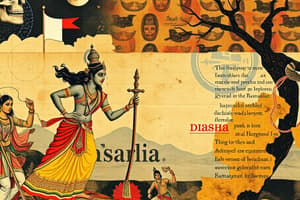Podcast
Questions and Answers
What was Shambuka's social status in the Hindu social hierarchy?
What was Shambuka's social status in the Hindu social hierarchy?
- Shudra (correct)
- Kshatriya
- Brahmin
- Vaishya
Why did Rama behead Shambuka?
Why did Rama behead Shambuka?
- Because Shambuka was performing austerities, a privilege of Brahmins and Kshatriyas (correct)
- Because Shambuka was not a believer in Lord Vishnu
- Because Shambuka was a devotee of Lord Rama
- Because Shambuka was a threat to Rama's rule
What does Shambuka's story highlight?
What does Shambuka's story highlight?
- The role of Brahmins in ancient Indian society
- The privilege of women in ancient India
- The importance of following one's duty according to one's social status (correct)
- The flexibility of the Hindu social hierarchy
What did Shambuka reveal to Rama when they met?
What did Shambuka reveal to Rama when they met?
How has Shambuka's story been viewed by scholars and social reformers?
How has Shambuka's story been viewed by scholars and social reformers?
During which era did Shambuka live?
During which era did Shambuka live?
राजद्वार का निर्माण किसके द्वारा किया गया है?
राजद्वार का निर्माण किसके द्वारा किया गया है?
राजद्वार अध्याय किसका हिस्सा है?
राजद्वार अध्याय किसका हिस्सा है?
राजद्वार किसके बीच की संक्रांति है?
राजद्वार किसके बीच की संक्रांति है?
राजद्वार का महत्त्व क्या है?
राजद्वार का महत्त्व क्या है?
राजद्वार अध्याय में कौन से देवी-देवता प्रमुख हैं?
राजद्वार अध्याय में कौन से देवी-देवता प्रमुख हैं?
राजद्वार अध्याय के प्रमुख विषय क्या हैं?
राजद्वार अध्याय के प्रमुख विषय क्या हैं?
राजद्वार का प्रतीक क्या है?
राजद्वार का प्रतीक क्या है?
राजद्वार का महत्त्व क्यों है?
राजद्वार का महत्त्व क्यों है?
राजद्वार अध्याय के माध्यम से क्या सीखा जा सकता है?
राजद्वार अध्याय के माध्यम से क्या सीखा जा सकता है?
Flashcards are hidden until you start studying
Study Notes
Shambuka's Story
Shambuka, a Shudra, was a devout worshipper of Lord Vishnu. He lived during the Ramayana era and was known for his intense devotion and austerities.
Background
- Shambuka was a Shudra, the lowest caste in the Hindu social hierarchy.
- Despite his low social status, Shambuka was driven by his desire to attain spiritual enlightenment.
Meeting with Rama
- Shambuka's intense austerities caught the attention of Rama, who was wandering in the forest with his brother Lakshmana.
- Rama, curious about Shambuka's activities, approached him and asked about his identity and purpose.
- Shambuka revealed his desire to attain spiritual enlightenment and his devotion to Lord Vishnu.
Consequences
- Rama, adhering to the traditional Hindu laws, beheaded Shambuka for performing austerities, which were considered the privilege of Brahmins and Kshatriyas.
- Shambuka's beheading was seen as a necessary act to maintain social order and prevent chaos in the world.
Significance
- Shambuka's story highlights the rigid social hierarchy of ancient India and the restrictions imposed on lower castes.
- The story also emphasizes the importance of following one's duty (dharma) according to one's social status.
Legacy
- Shambuka's story has been debated and critiqued by scholars and social reformers throughout history, with some viewing it as a symbol of social oppression and others as a testament to Rama's adherence to duty.
Shambuka's Story
Background
- Shambuka was a Shudra, the lowest caste in the Hindu social hierarchy.
- Despite being a Shudra, he was driven by his desire to attain spiritual enlightenment.
Meeting with Rama
- Shambuka's intense austerities caught the attention of Rama, who was wandering in the forest with his brother Lakshmana.
- Rama approached Shambuka, asking about his identity and purpose.
- Shambuka revealed his desire to attain spiritual enlightenment and his devotion to Lord Vishnu.
Consequences
- Rama beheaded Shambuka for performing austerities, a privilege reserved for Brahmins and Kshatriyas.
- Shambuka's beheading was seen as a necessary act to maintain social order and prevent chaos in the world.
Significance
- Shambuka's story highlights the rigid social hierarchy of ancient India and the restrictions imposed on lower castes.
- The story emphasizes the importance of following one's duty (dharma) according to one's social status.
Legacy
- Shambuka's story has been debated and critiqued by scholars and social reformers throughout history.
- Some view it as a symbol of social oppression, while others see it as a testament to Rama's adherence to duty.
Rajdwar Chapter Summary
Overview
- Rajdwar chapter is part of Shambook Khand Kavya, a Hindu scripture.
Story of Rajdwar
- Rajdwar is a sacred gate created by gods to connect mortal world to divine realm.
- Story revolves around significance of Rajdwar in devotees' spiritual journey.
Significance of Rajdwar
- Rajdwar symbolizes spiritual growth and self-realization.
- It's the threshold between material and spiritual worlds.
- Passage through Rajdwar necessary for spiritual enlightenment and liberation.
Key Characters
- Gods and goddesses from Hindu mythology are key characters, including Brahma, Vishnu, and Shiva.
- They played crucial role in Rajdwar's creation and significance.
Themes
- Spirituality, self-realization, and quest for liberation are major themes.
- Devotion and Rajdwar's role in facilitating devotees' spiritual journey are highlighted.
Symbolism
- Rajdwar represents spiritual growth and transformation.
- Gate symbolizes transition from ignorance to enlightenment.
Studying That Suits You
Use AI to generate personalized quizzes and flashcards to suit your learning preferences.




